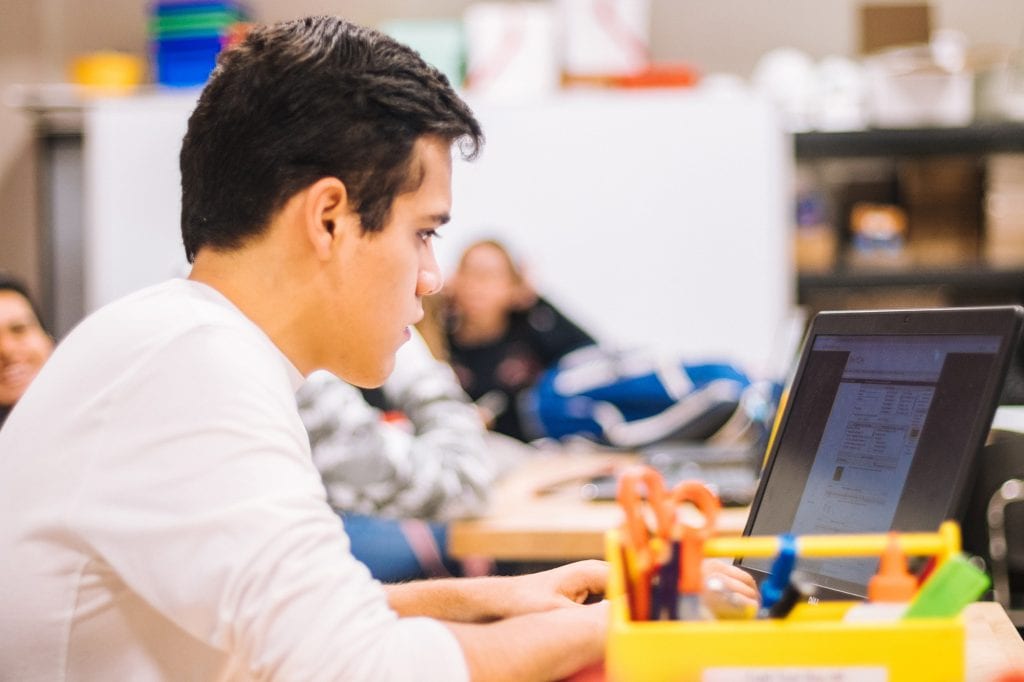How to manage the transition from Primary to Secondary school
It is getting to that point in the academic year where year six children are looking ahead to the big changes coming their way in September – the transition from primary school to secondary school. It is a big change for any child, but with the disruption that children have faced during the past two school years, it is an even bigger deal.
Of course, it is an exciting transition for many children. They get their first taste of freedom; perhaps using a bus on their own for the first time or walking to school, and have to take more ownership over their own learning. They also have the opportunity to meet new friends and new teachers, and try new extra-curricular clubs and activities. However, it can also be quite an anxious transition too. A new school – usually much bigger than their primary. New teachers. New routines. Detentions.
It is not only the children who feel anxious about this big change. Parents can often feel it as well, sometimes even more so. It is a sign that the children are growing up and no longer need them quite as much.
Here, we look at some of the things that you can do to help to manage the transition between primary school and secondary school, not for just your child, but for you too.

Encourage confidence
It all comes down to self-confidence when it comes to fitting in at a new secondary school with new people. Children who have lots of confidence in themselves are less likely to be bullied, to bully others, or to join gangs. They are more likely to have a large group of mates. They will confidently say “no” to something that makes them feel uncomfortable. So, do not be afraid to tell them how awesome they are. When was the last time you complimented them? They don’t have to have done something extraordinary to get one; a compliment on how well they care for a pet, or that they are kind or respectful, will suffice. Do this on a regular basis and watch their confidence shoot through the roof.
Listen to and acknowledge their fears
Your child may be nervous and concerned that their worries will be dismissed as insignificant. For example, what should they do if they get lost in the labyrinth of corridors? They could go to the school office – they should have a map – or ask a fellow student or teacher for support. What they can not do is hide in the toilets until the lesson has finished. Discuss the solutions with them. Do this for any worries that they might have, so they know you are taking them seriously. Also, remind them that they are unlikely to be the only student with the same fears and concerns and that when one person asks, everyone else will be relieved.
Make sure that they have all of the resources that they need
These days, a reliable internet connection and a device to work from for homework and coursework are essential. It does not have to be expensive – some kids will be working from flashy laptops, sure, but there are some great tablets under 100 that let them do what they need to do. Do not forget the basics either – pencil case with pens, pencils, rulers, geometry equipment, scientific calculator, notebook and suitable backpack to carry it in. They will almost definitely need a PE kit – perhaps multiple ones, so check the uniform list over before September rolls around. There is nothing more embarrassing for kids than to not have the equipment that they need.
Remind them of the importance of being a good friend
Remind your soon-to-be-secondary-aged child that one way to make friends is to be a good friend, particularly to shy and quiet children. Encourage them to invite friends over, and recommend it if they don’t.
Model positivity about the changes coming their way
As we mentioned earlier in the post, parents are often just as anxious, if not more so, than their children about the transition from primary school to secondary school, but it is important to keep that anxiety in check to a degree. Of course, it is natural to be worried and letting them see that is also important but focus on the positivity and excitement about going to secondary school. This is particularly important if it was not the first-choice school or you have lost out on admission appeals. If your child picks up that you have negative feelings about a school, they are going to go in expecting the worse.
Have a trial run of the journey to school
However they are getting there, whether by bus, driven in, by foot or cycling, have a trial run to make sure that they know the way and roughly how long the journey will take in the mornings. Factor in things like bad weather, missed buses, extra traffic, and so on into the journey time – it is better to leave a little earlier and get there early and calmly rather than rushing in and ending up hot, sweaty, and flustered, especially in the early days. It is also important to have contingency plans – if the car breaks down, the buses stop running or they lose their bus fare, how will they get to and from school?
Consider the changes that might be needed at home
Secondary school children generally have a lot more homework than they did at primary school and it is much more intense. Do you have the space and time to accommodate this? It might mean cutting down the number of after school activity clubs that they attend, moving dinner time forward (or pushing it back), and looking at how you manage other children in order to minimise distractions. If you have younger children, could they be sitting at the table doing a quiet jigsaw or doing some colouring while their older siblings do their homework in peace?
Encourage joining lunchtime and after school clubs
These are great places for your child to make friends with similar hobbies and interests to them and to be a part of the wider school community. However, it is important to make sure that they do not overdo it, particularly in the first few weeks and months while they are trying to get to grips with new routines and homework loads.
Encourage participation in orientation events
Most schools will offer some sort of orientation events or activities in the last term before and the summer holidays, such as ‘meet your new class day’ and summer school events. It is important that your child – and you, if appropriate – attend these events and activities. They will provide you and them with important information about routines and procedures, but also give everyone a chance to meet other pupils, parents, and staff in the school community.

Keep to a good bedtime and healthy meals
One of the best ways that you can support your child is by implementing a good bedtime routine and making sure they eat well. It is recommended that a child has around eight hours of sleep a night – try to avoid screentime for at least an hour before their bedtime to encourage natural and restful sleep. A healthy, balanced diet, with plenty of fruit and vegetables, proteins, carbohydrates, healthy fats, and calcium, as well as keeping hydrated will go a long way to making them feel at their very best ready to face their brand new school.
Talk about social media
Many social media platforms have a lower age limit of 13, but many children begin asking about joining them when they start secondary school. Before you make that decision, it is important to talk to them about how to use it appropriately, what details that they can and cannot share, and what to do if they come across any information that makes them feel uncomfortable. If you do choose to allow them to use social media, keep tabs on it and make sure that there is no bullying or inappropriate conversations happening.
Allow for some wobbles
It can take a while for a child to settle into a new school environment. While some are at home and managing to find their way around within a few days, don’t be alarmed if it takes weeks or even months for your child to settle into their secondary school. It is a huge change! There may also be plenty of wobbles along the way, once the initial excitement has faded away, and it can be frustrating for both you and them if they do not settle as quickly as you hoped. However, continued support and communication with the school if there are problems will go a long way towards making the process easier on everyone.
![[AD] We went to the newly opened Cha Sha Kingston a couple of weeks ago, and wow — taste bud adventure unlocked! The boys devoured the masala fries and chicken tikka rolls, while we couldn’t get enough of that epic kebab butter curry 😍🍛.
It’s amazing value for food this tasty (and everyone left happy and VERY full!).
Delicious food, vibrant vibes and incredible value — the perfect combo for your next meal.
📍Cha Sha Kingston
43 Surbiton Road, KT1 2HG
🌐 chasha.co.uk
Other Cha Sha locations in Birmingham, Ilford, Southampton and Wembkey
#ChaSha #ChaShaKingston #KingstonEats #FoodieFinds #UKFoodie #FoodReview #KingstonUponThames #FamilyEats #FamilyDining #FoodieKids](https://suburban-mum.com/wp-content/uploads/2016/02/574770541_18560351146016840_6855048070839528040_n-180x320.jpg)

![[AD] We’re a cricket-mad family, so we’re buzzing that @thehundred is back this August! 🏏🔥
To get ready, M tried out the official FREE Activity Pack — and it’s brilliant! 🙌
Packed with fun games, creative challenges and sporty tasks, it’s perfect for getting kids hyped whether you’re at home or on the go.
👉Download yours now (link in bio)
@londonspirit @ovalinvincibles #EveryMomentCounts #TheHundred
#EnglandCricket #CricketFamily #TheHundredCricket #LondonBloggers #Cricket #CricketIsLife #kidsfun](https://suburban-mum.com/wp-content/uploads/2022/11/505472555_18531279601016840_7092520074819907569_n-180x320.jpg)



![[AD - Press visit]
We enjoyed the glorious sunshine this weekend with a trip to Brighton. We went on the @brightoni360official which is right by the sea front.
The i360 pod take a slow journey up, allowing you to take in views across Brighton and the South Downs 450ft above ground. There’s a bar inside with drinks and snacks available to purchase and the experience lasts 25 minutes.
Afterwards, we headed to the open air roller rink for a roller skating session!
The roller rink is:
⭐ Suitable for over 5s
⭐ £6.50 if you have your own skates or £9.50 if you need to hire them
⭐ 45 minutes per session
Full details to visit the i360 + skating
📍 Brighton i360, Lower Kings Road, Brighton BN1 2LN
🚗 Parking nearby (we parked in the Regency Square Car park)
🎟️ Prices start from £25.40 for an adult and £16.90 for a child
🕐 Opening hours are currently Sun-Fri 10.30am-18.30pm and until 19.30pm on Saturdays
☕️ Bar inside the i360, cafe and gift shop
Book tickets here:
https://tickets.brightoni360.co.uk/tickets/?_ga=2.195305772.1869001490.1689671753-1757164059.1689671753/#events?eventid=157](https://suburban-mum.com/wp-content/uploads/2015/04/417980235_313576471048632_3682382982231216432_n.jpg)

![[AD] ***Summer of fun at Barracudas Activity Camps!****
There is plenty for kids to do at @barracudas_activity_day_camps
From Tennis, Archery, Swimming, Motor Sports and more you can be sure that there will be something for kids aged 4.5-14. ⚽🏈🥅🎾🏓🏎️🏹🏊♂️🏉
You can book on a day by day basis - so it can fit in with any other days out/activities you have planned and there are early drop off and late pickup options available. Barracudas are also Ofsted registered so you can use your Childcare Vouchers too.
⭐⭐⭐Get £20 off a week or £4 off a day using my discount code: MARIA20⭐⭐⭐
#BarracudasActivityDayCamp #BarracudasActivityCamp #BarracudaAmbassadors #SummerHolidays #SchoolHolidays #Summer2023 #SummerCamp #DayCare #Camp #KidsCamp #surreymummy #surreymums #SummerOfFun #ActivityCamps #HolidayCamps #Childcare #SchoolHolidays #schoolholidaycamps](https://suburban-mum.com/wp-content/uploads/2024/07/353583570_625625966167953_545896259645102575_n.jpg)



![[AD] We have some super exciting news...we have been chosen to be Laser Quest Ambassadors, and the boys are over the moon!
We are really lucky that our local Laser Quest (@laserquestkingston) is just around the corner from us. It means we can pop in of a weekend or anytime during the school holidays, and with summer just around the corner, I know Laser Quest will be one of our go-to places for some family fun.
As well as games of Laser Quest, there are also VR experiences and arcade amusements too. To find out a bit more about how Laser Quest works, you can read my blog post: https://www.suburban-mum.com/laser-quest-kingston/ (clickable link in bio)
Don't forget to keep an eye out for our Laser Quest posts - I'm going to be giving away two family passes to use at Laserquest Kingston!
If you can't wait and want to head down to Laser Quest to try it out, use the code SUMMER30 for 30% off your booking. The code is valid from now until the end of August 2023 and can be used on Laser Quest games and birthday party bookings.
#LaserquestAmbassador #Laserquest #LaserquestKingston #ActivitiesForKids #FamilyFun #DaysOutWithKids #Lasertag #LaserquestVR #Kingston #ThingsToDoInKingston #SurreyFamilyDaysOut #ThingsToDoWithKids #RainyDayFun #SurreyMummy #SurreyLife #LifeWithKids #LifeWithBoys #familyfunday](https://suburban-mum.com/wp-content/uploads/2015/04/353230107_797358078406942_2405522556733455165_n.jpg)

![[AD] The sun has finally made an appearance and the boys have been making the most of it by spending it
in the garden.
They’re go-to is always football and they’ve been trying to improve their aim and accuracy with the new Messi Foldable Footlball goal from the #MessiTrainingSystem range.
I love the fact the goal is foldable, making it easy to store away when not in use. It is also lightweight so you can effortlessly pack it up and take it to the park or to a friend’s house.
The Messi Foldable Football Goal retails at £36 and can be purchased from @argos
You can read my full review here: https://www.suburban-mum.com/messi-foldable-football-goal/
#TrainLikeMessi #FoldableFootballGoal #FootballSkills #OutdoorFun #LionelMessi #LeoMessi #FootballAtHome #OutdoorKids #JustGetOutside #OutdoorsAndFree #ScreenFreeKids #WhateverTheWeatherKids @flair_gp](https://suburban-mum.com/wp-content/uploads/2015/04/341194882_615024710178056_41977149395989448_n.jpg)

![[AD] We are absolutely thrilled to announce that we are Barracuda Ambassadors again this year.
With Easter just around the corner, the boys were sent the @barracudas_activity_day_camps new camp kit in preparation for the school holidays.
There’s a wide range of activities for kids aged 4.5 - 14 including Tennis, Archery, Basketball, Arts & Crafts and more.
If you like the sound of Barracudas, find out more over on their website. You can also save £20 a week or £4 a day, using my discount code: MARIA20](https://suburban-mum.com/wp-content/uploads/2024/07/336812306_765234558514317_685553691647241974_n.jpg)


![[AD - Gifted]
Last weekend we were invited to try out @tsarettaspice’s new Bottomless Brunch menu and I can tell you it was thumbs up all round!
There’s a good choice tapas on offer from Punjabi fish fingers, Indo Chinese Chicken to Spiced Lamb Scotch Eggs and Manchurian Cauliflower (which was amazing!)
If you’re local to Twickenham and fancy giving them a try here’s are the details.
Tsaretta Spice Bottomless Brunch
⭐️£37.50 per head for bottomless Prosecco or cocktail of the day
⭐️£55 per head for bottomless Champagne
⭐️ Food included: 4 tapas selections and dessert or 2 tapas selections, a pav or naanwich and dessert
⭐️ Non-alcohol brunch is also available
Tsaretta Spice
55 Church Street
Twickenham
TW1 3NR
You can also read our full review over on the blog (link in bio)](https://suburban-mum.com/wp-content/uploads/2024/07/334565436_5960402314015030_663031098700829518_n.jpg)



